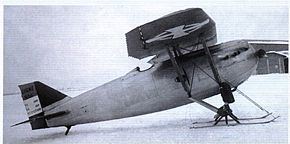The Dewoitine D.1 was a French single-seat fighter aircraft of the 1920s, built by the French industrial company Dewoitine.
The D.1 was the first airplane designed by Emile Dewoitine after he established his own company. The D.1 was designed to meet requirements issued by the French Service Technique de l'Aeronautique. It was a high-wing monoplane, with a metal oval-section fuselage with duralumin sheet skinning, and a metal strut-braced parasol wing with fabric covering. The first prototype (D.1.01) flew in November 1922. Derivatives of the D.1 were fitted with a variety of engines and wing designs.
The D.1 was demonstrated in several countries. Yugoslavia purchased 79, Switzerland two, and Japan one. Italy purchased one, but then constructed 112 of their own version under the designation Ansaldo AC.2.
The French Air Force did not put the D.1 into service, but the French Navy acquired 30 D.1ter's, 15 of which equipped Escadrille 7C1 and operated off the French aircraft carrier Béarn.
D.1.01the first prototype with high set wing with no pylon or cabane struts;(one built).
D.1Pre-series aircraft, some without pylon and some with pylon to D.1bis standard;(15 built).
D.1bisImproved version with the wings raised 4.75 in (121 mm) on a short pylon: some pre-series and production aircraft were built to this standard, but most were built or modified to D.1ter standard.
D.1terThe ultimate production standard D.1 with the wings supported on cabane struts in place of the pylon used on the D.1bis.
D.8A high-altitude derivative of the D.1, fitted with an enlaged wing of wooden construction and a high compression Hispano-Suiza 8Fe engine. Submitted to the CEDANA (
Commission dÉxamen des Appareils Nouveaux pour lÁeronautique) for the 1921 C1 fighter competition , the D.8 failed to attract an order due to the high altitude class specification being withdrawn. The sole D.8 went on to establish some closed circuit speed records in 1924;(one built).
D.9The
D.9 was derived from the D.1, for entry into the 1924 C1 fighter competition, by fitting a 313 kW (420 hp) Gnome-Rhône 9Ab (Jupiter IV) engine and later an enlarged wing. Unsuccessful in
France, the
D.9 had some export success with ten delivered to overseas customers and 150 built for the Swiss Fliegertruppe as the Ansaldo AC.3;(ten built).
D.12The D.12 was developed in parallel to the D.9 for the 1923 C1 competition, powered by a 336 kW (450 hp) Lorraine-Dietrich 12E. Later fitted with a high compression engine the D.12 was unsuccessful in gaining a production contract;(two built).
D.19The D.19 was another response to the 1923 C1 fighter competition, fitted with a 400 hp (298.3 kW) Hispano-Suiza 12Jb engine. Two prototypes took part in the competition and four more were delivered to
Belgium and
Switzerland;(six built).
D.21In the latter half of 1925 the second prototype D.12 was re-engined with a 500 hp (372.8 kW) Hispano-Suiza 12Gb engine. Intended for export the
D.21 garnered reasonable success acquiring orders for 34 plus licence manufacture of a further 64 in Czecho-Slovakia and Argentina;(100 built).
Ansaldo AC.1A single example of the D.1 assembled by Aeronautica Ansaldo SA prior to production of the modified AC.2 version;(1 built).
Ansaldo AC.2The D.1 was built under licence by Ansaldo in
Italy. 112 were built for the
Regia Aeronautica;(112 built).
Ansaldo AC.3Licence production of the D.9 derivative in Switzerland;(150 built).
Ansaldo AC.4A direct descendant of the AC.2 the AC.4 replaced the HS 42 engine with a 420 hp (313.2 kW) FIAT A.20 engine. Flown in 1927;(1 built).
CzechoslovakiaOne D.1bis aircraft. FranceFrench NavyEscadrille 7C3 - Escadrille 6C3 Kingdom of ItalyRegia Aeronautica JapanOne D.1bis aircraft. SwitzerlandSwiss Air Force - Two D.1bis aircraft. Kingdom of YugoslaviaRoyal Yugoslav Air ForceGeneral characteristics
Crew: oneLength: 7.50 m (24 ft 7.25 in)Wingspan: 11.50 m (37 ft 8.75 in)Height: 2.75 m (9 ft 0 in)Wing area: 20.00 m2 (215.29 ft2)Empty weight: 820 kg (1,808 lb)Gross weight: 1,240 kg (2,734 lb)Powerplant: 1 × Hispano-Suiza 8Fb inline piston, 224 kW (300 hp) eachPerformance
Maximum speed: 255 km/h (158 mph)Range: 400 km (249 miles)Service ceiling: 8,000 m (26,245 ft)Rate of climb: 450 m/s (1,476 ft/min)Armament
2 × fuselage-mounted synchronised 7.7 mm (0.303 in) Vickers machine guns
